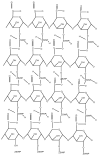Therapeutic Potential of Pectin and Its Derivatives in Chronic Diseases
- PMID: 38398646
- PMCID: PMC10892547
- DOI: 10.3390/molecules29040896
Therapeutic Potential of Pectin and Its Derivatives in Chronic Diseases
Abstract
Non-communicable diseases (NCDs) are described as a collection of chronic diseases that do not typically develop from an acute infection, have long-term health effects, and frequently require ongoing care and therapy. These diseases include heart disease, stroke, cancer, chronic lung disease, neurological diseases, osteoporosis, mental health disorders, etc. Known synthetic drugs for the treatment or prevention of NCDs become increasingly dangerous over time and pose high risks due to side effects such as hallucination, heart attack, liver failure, etc. As a result, scientists have had to look for other alternatives that are natural products and that are known to be less detrimental and contain useful bioactive compounds. The increasing understanding of the biological and pharmacological significance of carbohydrates has helped to raise awareness of their importance in living systems and medicine, given they play numerous biological roles. For example, pectin has been identified as a class of secondary metabolites found in medicinal plants that may play a significant role in the treatment and management of a variety of NCDs. Pectin is mainly made of homogalacturonan, which is a linear polymer composed primarily of D-galacturonic acid units (at least 65%) linked in a chain by α-(1,4)-glycosidic linkages. There are also modified pectins or derivatives that improve pectin's bioavailability. Pectin is found in the cell walls of higher plants (pteridophytes, angiosperms, and gymnosperms), particularly in the middle lamella of the plant material. Citrus pectin is used in various industries. This article compiles information that has been available for years about the therapeutic importance of pectin in chronic diseases, different modes of pectin extraction, the chemistry of pectin, and the potency of pectin and its derivatives.
Keywords: bioactivity; bioavailability; biological studies; clinical trials; derivatives; natural products; non-communicable diseases; pectin.
Conflict of interest statement
The authors declare no conflicts of interest.
Figures







References
-
- Rao K.D., Mehta A., Kautsar H., Kak M., Karem G., Misra M., Joshi H., Herbst C.H., Perry H.B. Improving quality of non-communicable disease services at primary care facilities in middle-income countries: A scoping review. Soc. Sci. Med. 2023;320:115679. doi: 10.1016/j.socscimed.2023.115679. - DOI - PubMed
-
- Brenyah J.K., Nonvignon J., Singh A., Owusu-Dabo E. Tobacco consumption and non-communicable diseases in Ghana; Identifying accentuating factors and further evidence from 2014 Ghana demographic and health survey. Sci. Afr. 2023;20:e01665. doi: 10.1016/j.sciaf.2023.e01665. - DOI
Publication types
MeSH terms
Substances
Grants and funding
LinkOut - more resources
Full Text Sources
Research Materials

